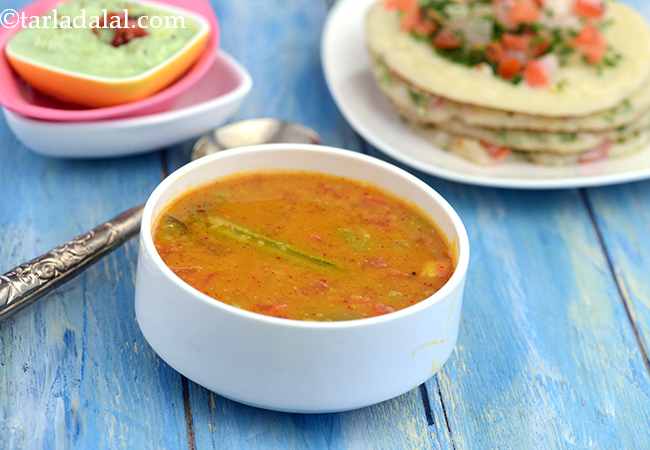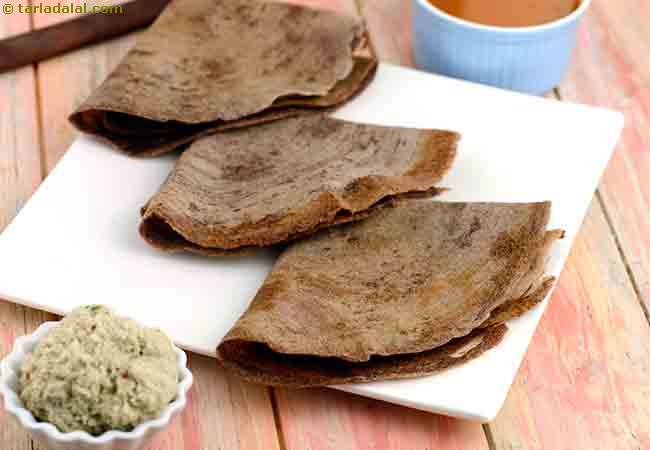See Whole Moong Dosa calorie. whole moong dosa recipe | healthy whole moong dosa | protein rich dosa is a wholesome and filling Indian breakfast option.
To make whole moong dosa, combine rice, urad dal and whole moong, add enough water and soak for 4 hours. Drain and blend with water to make batter. Allow it to ferment well. Meanwhile make a stuffing by combining onions, coriander, green chillies and salt. Make nice soft whole moong dosas from the batter and stuff with a portion of the stuffing. Remember to serve whole moong dosa hot for best flavours.
The use of whole moong in this healthy whole moong dosa offers culinary and nutritious benefits. While its rich
fiber content helps lower
cholesterol levels, it also gives the whole moong dosa a mild and enjoyable crunch. Moong along with rice makes a good protein as a vegetarian meal.
The stuffing of onions, coriander and green chillies also adds to the appeal of pesarattu dosa, both in terms of flavour and texture.
Have this
protein rich whole moong dosa for
breakfast and gain in 8.9 g protein per dosa. That’s a good amount of protein which will help nourish the cells and tissues of the body. Serve whole moong dosa with hot
Sambhar.

Sambhar ( How To Make Sambhar, South Indian Recipe)
Is Whole Moong Dosa healthy?
Yes, this is healthy.
Lets understand the ingredients of Whole Moong Dosa.
What's good in this Whole Moong Dosa!
Mung, Moong, Whole green gram, Mung beans : Mung is rich in Folate (Vitamin B9 or Folic Acid) helps your body to produce and maintain new cells, especially red blood cells. Being rich in Antioxidants like Flavonoids, mung reduces the damage done by free radicals to the blood vessels and lowers inflammation. They help in the free flow of blood and is good for heart. As Moong is low in fat and high in protein and fibre, eating mung beans will keep you fuller for a longer time and great for weight loss. See detailed benefits of moong.
Urad Dal : 1 cup of cooked urad dal gives 69.30% of your daily requirement of folic acid. The folic acid in urad dal helps your body to produce and maintain new cells, especially red blood cells. Being rich in Phosphorus it works with Calcium to build our bones. It is also high in fibre and good for heart, good for lowering cholesterol and good for diabetes. See here for 10 super benefits of urad dal.
Onions (pyaz, kanda) : Raw onions are a very valuable source of vitamin C – the immune building vitamin. Along with other phytonutrients from onions, it helps to build WBC (white blood cells) which serves as a line of defence against illness. Yes, it’s a source of many antioxidants, the most important one amongst them being Quercetin. The quercetin in Onions promotes production of HDL (good cholesterol) and lowers total cholesterol in the body. The sulphur in onions act as a blood thinner and prevents blood clotting too. This in turn would lower blood pressure and good for heart, diabetics. Read the benefits of onions.
Coriander (kothmir, dhania) : Coriander is a fresh herb often used as a flavour enhancer in Indian cooking. It is mainly used as a garnish. This is the best way to use it - no cooking. This preserves its vitamin C content which helps to build our immunity and bring that sparkle to the skin. The antioxidants vitamin A, vitamin C and the quercetin present in coriander works towards strengthening our immune system. Coriander is a fairly good source of iron and folate – the 2 nutrient which help in the production and maintenance of red blood cells in our blood. Good for reducing cholesterol and good for diabetics. Read 9 benefits of coriander to understand details.
Green Chillies : Antioxidant vitamin C in green chillies protects the body from effects of harmful free radicals and prevents stress. It is probably the high fiber which helps in controlling blood sugar levels. This it is a welcome addition to a diabetic diet. Suffering from anaemia? Add green chillies to your list of iron rich foods too. For complete details see benefits of green chilli.
What's problem in this Whole Moong Dosa!
Rice : Here are the pros for rice. Rice is a great source of complex carbohydrates, which is an important source of energy for our body. Rice is low in fibre and therefore a good option for people suffering from diarrhoea. What's not good in rice. Foods like rice are high in Glycemic index are not suitable for weight loss, heart patients, diabetics as they affect the blood sugar control levels. See details of is white rice and parboiled rice good for you?
Vegetable Oils : To some vegetable oil is only soyabean oil, while some promote it as a mix of oils like soyabean, canola, sunflower, corn and other omega-6 rich oils. These are often cheaper options than many oils, but they are highly processed oils. They are undoubtedly not to be reached out for, whether you are looking for salad dressings, sautéing or cooking. The 5 best oils used in cooking are olive oil (low temperature short time cooking), avocado oil, canola oil, coconut oil and peanut oil. You must read the super article to find the facts of which oil is the healthiest avoid vegetable oil.
Can diabetics, heart patients and over weight individuals have Whole Moong Dosa?
No, this recipe is not healthy and good for diabetics, heart and weight loss.
Can healthy individuals have Whole Moong Dosa?
Yes, this is healthy. But restrictions apply.
What are the healthier dosa recipes?
Opt for nachni dosa, quinoa dosa, oats dosa, 4 Flour Dosa recipe, spinach dosa or buckwheat dosa which has ZERO rice used. Serve it with a healthy sambar recipe or coconut chutney. Read which idlis and dosas are healthy?

Nachni Dosa
Whole Moong Dosa is high in
1. Folic Acid : Folic acid is an essential vitamin required throughout pregnancy.
2. Phosphorous : Phosphorous works closely with calcium to build bones.
3. Vitamin B1 : Vitamin B1 protects nerves, helps in carbohydrate metabolism, prevents heart diseases and helps produce red blood cells.
4. Fiber : Dietary fiber reduce the risk of heart disease, prevent the spike in blood sugar levels and hence super for diabetics. Consume more fruits, vegetables, moong, oats, matki, whole grains.
Note : a recipe is deemed high in a Vitamin or mineral if it meets 20% and above the recommended daily allowance based on a 2,000 calorie diet.
How to burn 153 calories that come from Whole Moong Dosa?
Walking (6 kmph) = 46 mins
Running (11 kmph) = 15 mins
Cycling (30 kmph) = 20 mins
Swimming (2 kmph) = 26 mins
Note: These values are approximate and calorie burning differs in each individual.